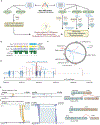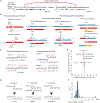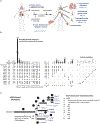A genetic basis for sex differences in Xp11 translocation renal cell carcinoma
- PMID: 39168126
- PMCID: PMC11455617
- DOI: 10.1016/j.cell.2024.07.038
A genetic basis for sex differences in Xp11 translocation renal cell carcinoma
Abstract
Xp11 translocation renal cell carcinoma (tRCC) is a rare, female-predominant cancer driven by a fusion between the transcription factor binding to IGHM enhancer 3 (TFE3) gene on chromosome Xp11.2 and a partner gene on either chromosome X (chrX) or an autosome. It remains unknown what types of rearrangements underlie TFE3 fusions, whether fusions can arise from both the active (chrXa) and inactive X (chrXi) chromosomes, and whether TFE3 fusions from chrXi translocations account for the female predominance of tRCC. To address these questions, we performed haplotype-specific analyses of chrX rearrangements in tRCC whole genomes. We show that TFE3 fusions universally arise as reciprocal translocations and that oncogenic TFE3 fusions can arise from chrXi:autosomal translocations. Female-specific chrXi:autosomal translocations result in a 2:1 female-to-male ratio of TFE3 fusions involving autosomal partner genes and account for the female predominance of tRCC. Our results highlight how X chromosome genetics constrains somatic chrX alterations and underlies cancer sex differences.
Keywords: MITF; TFE3; X chromosome; X inactivation; XIST; cancer genomics; cancer sex bias; gene fusions; kidney cancer; renal cell carcinoma; tRCC; translocation renal cell carcinoma.
Copyright © 2024 Elsevier Inc. All rights reserved.
Conflict of interest statement
Declaration of interests S.R.V. has consulted for Jnana Therapeutics within the past 3 years and receives research support from Bayer. C.-Z.Z. is a co-founder, consultant, and equity holder of Pillar Biosciences, a for-profit company specialized in assay development for targeted DNA sequencing. C.B. is currently an employee of Inocras Inc., a for-profit company specialized in whole-genome sequencing of cancer and rare diseases. T.K.C. reports institutional and/or personal, paid and/or unpaid support for research, advisory boards, consultancy, and/or honoraria past 5 years, ongoing or not, from Alkermes, Arcus Bio, AstraZeneca, Aravive, Aveo, Bayer, Bristol Myers Squibb, Calithera, Circle Pharma, Deciphera Pharmaceuticals, Eisai, EMD Serono, Exelixis, GlaxoSmithKline, Gilead, HiberCell, IQVA, Infinity, Ipsen, Jansen, Kanaph, Lilly, Merck, Nikang, Neomorph, Nuscan/PrecedeBio, Novartis, Oncohost, Pfizer, Roche, Sanofi/Aventis, Scholar Rock, Surface Oncology, Takeda, Tempest, Up-To-Date, CME events (Peerview, OncLive, MJH, CCO, and others), and outside the submitted work; has institutional patents filed on molecular alterations and immunotherapy response/toxicity and ctDNA; holds equity in Tempest, Pionyr, Osel, Precede Bio, CureResponse, InnDura Therapeutics, and Primium; and is on the committees of NCCN, GU Steering Committee, ASCO (BOD 6-2024-, ESMO, ACCRU, and KidneyCan (medical writing and editorial assistance support may have been funded by Communications companies in part); and has mentored several non-US citizens on research projects with potential funding (in part) from non-US sources/Foreign Components. The institution (Dana-Farber Cancer Institute) may have received additional independent funding of drug companies or/and royalties potentially involved in research around the subject matter. D.J.E. received research funding to institution from Bristol-Myers Squibb, Cardiff Oncology, MiNK Therapeutics, Novartis, Sanofi, and Puma. Discounted research sequencing from Foundation Medicine.
Figures






Update of
-
A genetic basis for cancer sex differences revealed in Xp11 translocation renal cell carcinoma.bioRxiv [Preprint]. 2023 Aug 6:2023.08.04.552029. doi: 10.1101/2023.08.04.552029. bioRxiv. 2023. Update in: Cell. 2024 Oct 3;187(20):5735-5752.e25. doi: 10.1016/j.cell.2024.07.038. PMID: 37577497 Free PMC article. Updated. Preprint.
References
-
- Choueiri TK, Lim ZD, Hirsch MS, Tamboli P, Jonasch E, McDermott DF, Dal Cin P, Corn P, Vaishampayan U, Heng DYC, et al. (2010). Vascular endothelial growth factor-targeted therapy for the treatment of adult metastatic Xp11.2 translocation renal cell carcinoma. Cancer 116, 5219–5225. 10.1002/cncr.25512. - DOI - PMC - PubMed
-
- Malouf GG, Camparo P, Oudard S, Schleiermacher G, Theodore C, Rustine A, Dutcher J, Billemont B, Rixe O, Bompas E, et al. (2010). Targeted agents in metastatic Xp11 translocation/TFE3 gene fusion renal cell carcinoma (RCC): a report from the Juvenile RCC Network. Ann Oncol 21, 1834–1838. 10.1093/annonc/mdq029. - DOI - PubMed
-
- Boilève A, Carlo MI, Barthélémy P, Oudard S, Borchiellini D, Voss MH, George S, Chevreau C, Landman-Parker J, Tabone M-D, et al. (2018). Immune checkpoint inhibitors in MITF family translocation renal cell carcinomas and genetic correlates of exceptional responders. j. immunotherapy cancer 6, 159. 10.1186/s40425-018-0482-z. - DOI - PMC - PubMed
MeSH terms
Substances
Grants and funding
LinkOut - more resources
Full Text Sources
Medical
Research Materials
Miscellaneous

